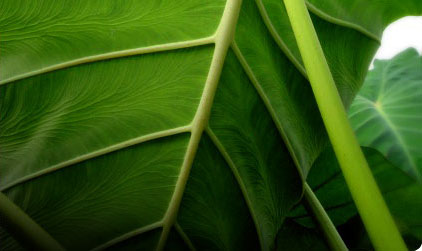Use As Food
Mainly eaten as a table taro.
Distribution
Limited; usually grown under māla (upland) culture.
General Characteristics
Medium in height to tall, slender, moderately spreading, maturing within 15 to 18 months, producing from 2 to 5 ‘ohā readily identified by profuse light and dark green Hā (Petiole) stripes and light pinkish lihi (stem edge).
Ha (Petiole)
70 to 100 cm. long, light and dark green-striped throughout length of Hā (Petiole), the dark stripes predominating, slightly tinged with purple on upper half, purplish at top (apex), white to greenish-white at kōhina (base), light pinkish at the lihi (stem edge).
Lau or Lu'au(Leaf Blade)
35 to 60 cm. long, 30 to 40 cm. wide, 30 to 45 cm. from tip to base of sinus (māwae), arrow head shaped, thin in texture, slightly patchy color (mottled) dark and light green with bluish cast; margins slightly wave-like (undulate); piko purple round leaf section (lobes) acute with narrow lihi māwae (sinus).
'I'o kalo (Corm)
Flesh white with yellowish fibers; skin white to cream colored.
Pua (Flower)
Hā (peduncle) green- and white-striped; flower cover (spathe) about 24 cm. long, the lower tubular portion 4 to 5 cm. long, green- and white-striped, the upper section yellow, lightly rolled or sometimes open near constriction (skinny part of flower); spadix (spike of flower) 8 cm, long, the sterile appendage (tip of flower's spike) 7 mm. long.
Remarks
